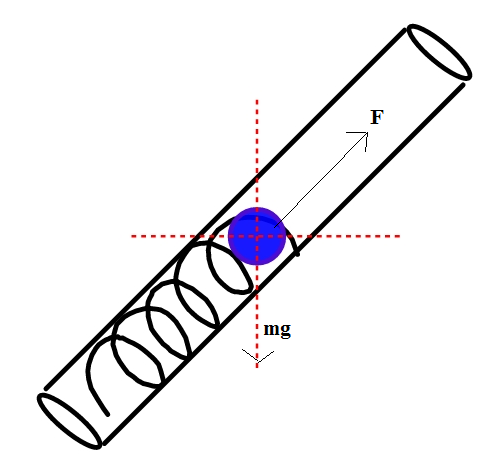Answer
390.9k+ views
Hint: Spring initially will be compressed due to the weight of the ball and restoring force due to the spring will be exerted on the ball. When anybody freely falls under gravity it experiences weightlessness.
Complete answer:
We are given that the spring is inclined initially so we assume that it makes an angle $\theta$ with the horizontal. When we put a ball in this inclined spring, the restoring force of the spring will be equal to the cosine of the angle with the (horizontal) axis.
$mg \cos \theta = F$

Consider the case of an elevator undergoing acceleration downwards now.
W = m (g-a)
is the weight when the a is the acceleration.
When the same elevator undergoes freefall, then a becomes g so the weight of the body in it becomes zero:
W = m(g-g) = 0.
In our case, the acceleration downwards is due to gravity and the resultant from the spring’s restoring force gives us:
$ mg = mg – F \sin \theta $
This gives us directly F=0 as $\theta$ is not zero. Therefore, the spring does not feel any compression. The spring therefore expands and throws the ball out. These results were because we were already given that the uncompressed spring in the tube filled the entire tube.
So, the correct answer is “Option D”.
Note:
If a body undergoes acceleration upwards, then the acceleration is added to g and the weight increases. If there is downwards acceleration, the weight of the body decreases. We are clearly able to tell without any mathematical expressions that the ball will exert no force on the spring due to freefall. Between option (C) and (D), we chose (D) only because the spring filled the tube initially.
Complete answer:
We are given that the spring is inclined initially so we assume that it makes an angle $\theta$ with the horizontal. When we put a ball in this inclined spring, the restoring force of the spring will be equal to the cosine of the angle with the (horizontal) axis.
$mg \cos \theta = F$

Consider the case of an elevator undergoing acceleration downwards now.
W = m (g-a)
is the weight when the a is the acceleration.
When the same elevator undergoes freefall, then a becomes g so the weight of the body in it becomes zero:
W = m(g-g) = 0.
In our case, the acceleration downwards is due to gravity and the resultant from the spring’s restoring force gives us:
$ mg = mg – F \sin \theta $
This gives us directly F=0 as $\theta$ is not zero. Therefore, the spring does not feel any compression. The spring therefore expands and throws the ball out. These results were because we were already given that the uncompressed spring in the tube filled the entire tube.
So, the correct answer is “Option D”.
Note:
If a body undergoes acceleration upwards, then the acceleration is added to g and the weight increases. If there is downwards acceleration, the weight of the body decreases. We are clearly able to tell without any mathematical expressions that the ball will exert no force on the spring due to freefall. Between option (C) and (D), we chose (D) only because the spring filled the tube initially.
Recently Updated Pages
Assertion The resistivity of a semiconductor increases class 13 physics CBSE

The branch of science which deals with nature and natural class 10 physics CBSE

The Equation xxx + 2 is Satisfied when x is Equal to Class 10 Maths

What is the stopping potential when the metal with class 12 physics JEE_Main

The momentum of a photon is 2 times 10 16gm cmsec Its class 12 physics JEE_Main

How do you arrange NH4 + BF3 H2O C2H2 in increasing class 11 chemistry CBSE

Trending doubts
Assertion CNG is a better fuel than petrol Reason It class 11 chemistry CBSE

How does pressure exerted by solid and a fluid differ class 8 physics CBSE

Number of valence electrons in Chlorine ion are a 16 class 11 chemistry CBSE

What are agricultural practices? Define

What does CNG stand for and why is it considered to class 10 chemistry CBSE

The rate of evaporation depends on a Surface area b class 9 chemistry CBSE

Difference between Prokaryotic cell and Eukaryotic class 11 biology CBSE

State whether the following statement is true or false class 11 physics CBSE

A night bird owl can see very well in the night but class 12 physics CBSE



